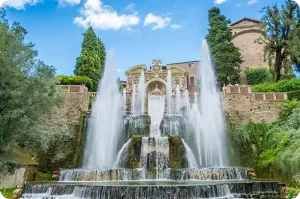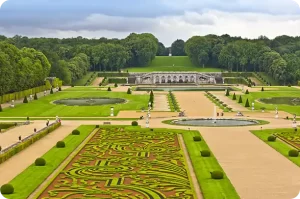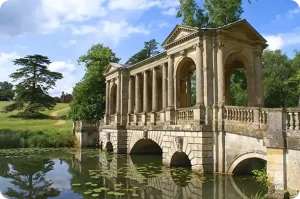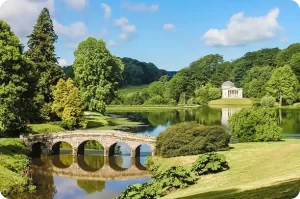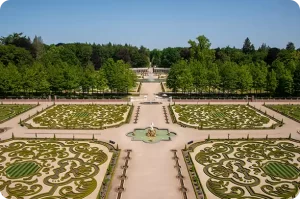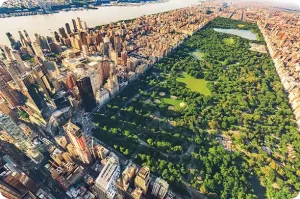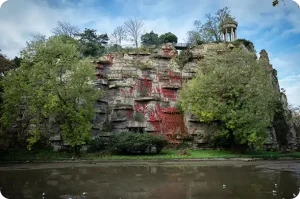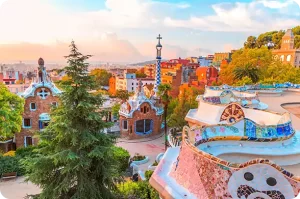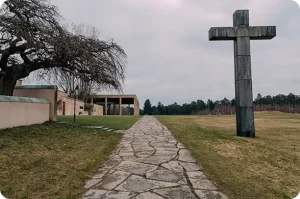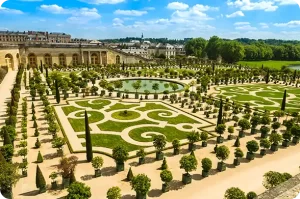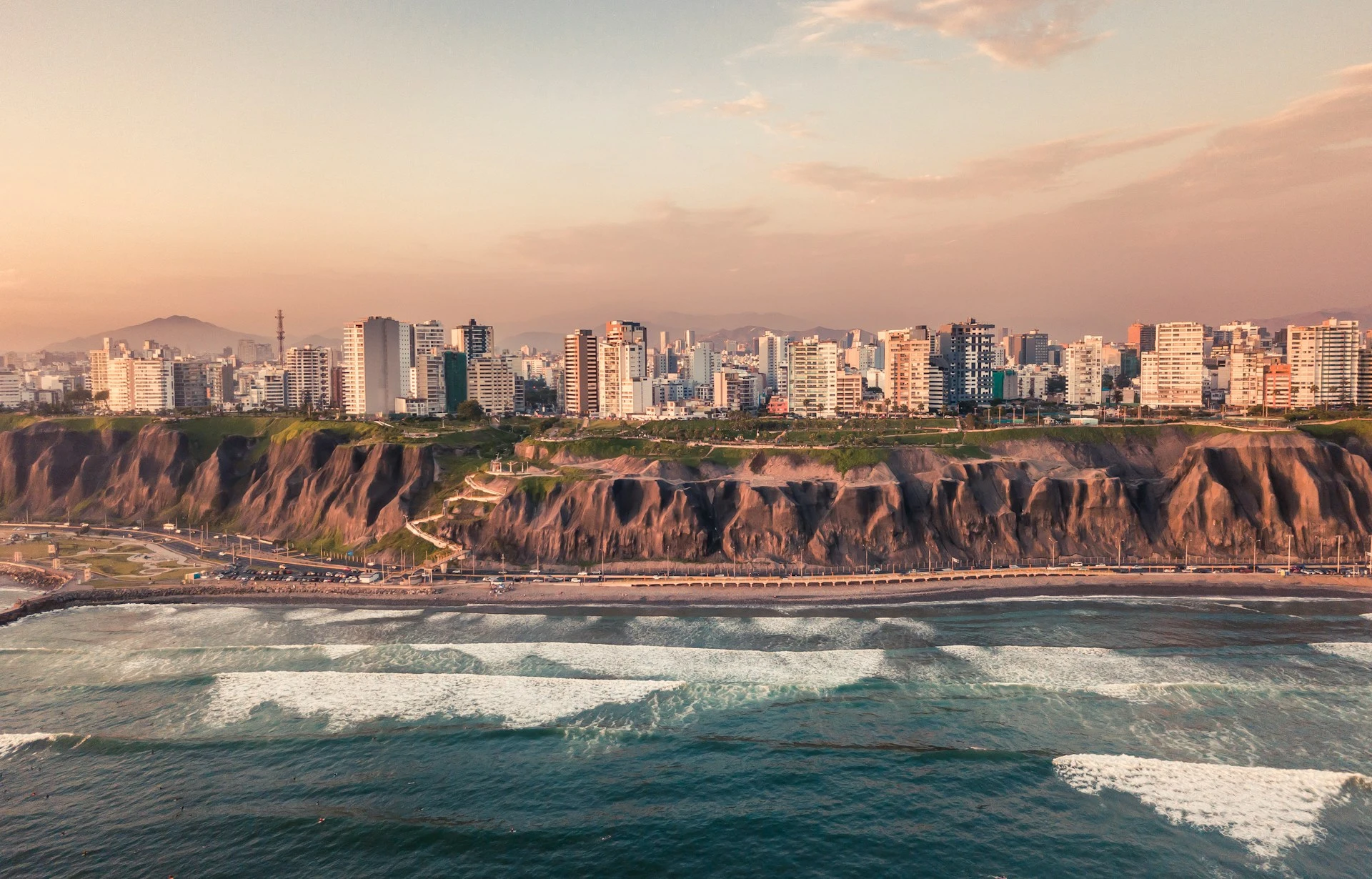So, we’ve heard about what it means to be a landscape architect, and we’ve visited 11 other locations already.
Now let’s finish up our list with these special must-see examples of superb landscape architecture!
#1. Villa d’Este (Tivoli, Italy)
In 1550, Tivoli governor Cardinal Ippolito Il d’Este of Ferrara requested that Pirro Ligorio create one of the first giardini delle meraviglie (Garden of Wonders). Ligorio incorporated old parts of the Franciscan monastic grounds into the gardens, and an aqueduct from the Aniene River was created to supply the fountains with water through gravity due to the sloped nature of the landscape. The fountain arrangement in the garden was meant to camouflage the odd layout of the villa due to working around the monastery, giving the illusion that the palace was in the center rather than off to the side.
In actuality, the villa aligned with the Tiburtine Sibyl temple at the top of the Tivoli Falls, which is just one of many Roman mythology references throughout the villa. Along with the Room of Hercules with a fresco on the ceiling of Hercules being praised and various Hercules myth statues lining the hallway, there is an unfinished Fountain of Neptune.
The most breathtaking aspect of Villa d’Este, however, is the Fontana del Bicchierone, or Fountain of the Great Glass, that was built by Gian Lorenzo Bernini, the developer of the Baroque style in sculpture. He shaped the fountain like a serrated chalice, and a jet of water falls over the lip of the chalice into a conch shell.
#2. Vaux-le-Vicomte (Maincy, France)
Designed by André Le Nôtre (keep that name in mind), the originator of the French 17th-century Classical style, this garden was for Nicolas Furquet, Louis XIV’s Superintendent of Finances, and was a prime example of the Jardin à la française, the popular French aesthetic of formal gardens.
The original boxwood of the boulingrins has been temporarily replaced by Patrick Hourcade’s Ephermeral Ribbons art, inspired by Achille Duchêne’s arabesque drawings. Interestingly enough, Duchêne was in turn inspired by Le Nôtre’s garden embroidery patterns!
The artwork is made up of 390 angled, unique aluminum plaques that give a reflection of the sky. As you journey through the garden, interlocking parts seem to cleverly appear and disappear due to intentional shifts in elevation. On top of this, there are cone-shaped yew trees lining the entrance and symmetrical beds of box hedges patterned like a brocade on the property, too.
The Great Gardens of the World says, “The broderie parterres, ponds, fountains and statuary, along with all the plants and buildings, are a unique achievement whose harmony and well-judged proportions charm the visitor from the very first glance…their perfect balance and the interplay of false symmetries…[shows] the metaphysical ideal of the gardener, who bends nature to suit his purpose.” Today, there is a treasure hunt included for children who can follow the tracks of a “Little Squirrel” throughout the gardens.
#3. Stowe Landscape Gardens (Buckinhamshire, England)
A solid team of individuals are credited with designing these gardens for the Temple family, the former dukes of Buckingham. Charles Bridgeman, John Vanburgh, and Lancelot “Capability” Brown were joined by William Kent, designer of the Royal Kew Botanic Gardens. Currently, the property is the site for the Stowe School.
Also, one of four Palladian bridges in the world is there and was added in 1744. There is one at Stourhead Gardens in Wiltshire, Wilton in Salisbury, and Prior Park in Bath. Palladian bridges have an arch into an open pavilion that is supported by colonnades. The bridge is based off of Andrea Palladio’s rejected design for Venice’s Rialto Bridge, hence the name.
#4. Stourhead Landscape Gardens (Wiltshire, England)
Interestingly enough, the landscape architect for this property was also the inheritor. Henry Hoare II, with the help of Henry Flitcroft, created a man-made garden that was carefully arranged to appear natural. With inspiration from Claude Lorrain and Nicholas Poussin, the gardens are known for the rhododendrons that were planted by Hoare’s grandson, Richard Colt Hoare. Richard also imported American tulip trees and swamp cypresses between 1791 and 1838.
Next to their Palladian bridge is a miniature replica of the Pantheon. “[Stourhead Landscape Gardens] is one of the best examples of the English landscape style of garden,” writes Britain Express, “a brilliant Arcadian design begun by Henry Hoare in 1741, incorporating ever-changing vistas around a lake, replete with temples to Apollo and Flora, a rock bridge, a cascade, a pantheon, a thatched cottage, and a grotto. The idea behind the Arcadian movement was to create an idealized version of classical antiquity…This is a vision of gardening where the garden is almost secondary to the philosophy of ordered nature (ordered and arranged by humans).”
#5. Het Loo (Willemsoord, Netherlands)
A series of symmetrical parterres and vistas, this Royal Palace garden was designed by Claude Desgotz. Parterres are spaces in a garden that have a decorative arrangement of flower beds. In the King’s Garden, for example, the courtyard parterre garden has an octagonal fountain in the middle. The design is a traditional boxwood edged with embroidery parterres on white pebbles. For the Great Garden, there is the same boxwood edging but with alternating turf-cut parterres. It is separated from the Upper Garden by a canal.
The Upper Garden has a semicircular pavilion and a peacock-tail-patterned fountain, which pays homage to the dozens of peacocks that roam the grounds. While the area was originally meant to be a hunting lodge for Prince William III, the palace was converted into a museum in 1970.
When Prince William and his wife Mary became king and queen, the gardens were extended. The gardens include the typical element of Dutch garden design, and that is the growth of fruit trees in the espalier form—tiered, controlled plant growth along a wall or fence. Not only is there a featured fountain of Venus with four swans in the Lower Garden, but there is also a hedge maze!
#6. Central Park (New York, New York)
There is no way I could have made a list without including the place that essentially started it all. Designed by Frederick Law Olmsted and Calvert Vaux who are credited with coining the term “landscape architecture,” Central Park has it all: gardens, bedrocks and hills, woodlands, bodies of water, lawns, and meadows. Vaux and Olmsted’s founding vision had three types of landscapes: pastoral, picturesque, and formal.
Pastoral
“A pastoral landscape is defined by its gentle, sprawling lawns, shaded walks, or broad expanses of placid water, evoking a feeling of peaceful spaciousness,” writes the Central Park Conservatory. For example, the North Meadow, which is the largest open meadow in Central Park, is one of the three areas with sports fields, including the Great Lawn and Heckscher Ballfields. The original plan was to have it be a place where people could play cricket, but it became an open meadow instead. The 20th century saw it eventually being used for baseball and soccer.
Picturesque
“A picturesque landscape is complex, rough, and irregular, compelling Park visitors to navigate winding pathways and encounter eclectic materials (such as wood, rocks, and water)…According to Olmsted, the picturesque landscapes are meant to ‘create a degree of obscurity not absolutely impenetrable, but sufficient to affect the imagination with a sense of mystery,’” the Central Park Conservatory quotes. The Ramble, which is one of three woodland landscapes in the park, covers 36 acres of land and has a stream, paths, and rustic bridges.
Located along the Lake and near the Bethesda Terrace and Belvedere Castle, The Ramble is meant to be a refuge from city life. Olmsted and Vaux’s design of The Ramble was inspired by the Catskills and the Adirondacks. There is even a bridge made entirely of rough stones to make it look like it arranged itself naturally called the Ramble Stone Arch. The Ramble is a great spot for birdwatchers who can log their sightings at the Central Park Boathouse.
Formal
Finally, there is the formal landscape style. “Olmsted and Vaux envisioned the Mall and Bethesda Terrace as the single formal feature of the Park, a grand promenade and ‘open-air reception hall for the people.’” The Mall is a straight path lined by two rows of American elm trees. The southern section is nicknamed the “Literary Walk” due to the statues of famous writers present there. In 2020, The Mall was the site for the very first monument added in 50+ years, the Women’s Rights Pioneers Monument.
The Conservatory Garden is six acres of three different landscape architecture styles: the French parterre-style in the North Garden, the Italian Renaissance-style for the Center Garden, and the English perennial-style in the South Garden. The Conservatory Garden is named after the original glass conservatory that had public seasonal plant displays. The area was also the original location for the greenhouse Vaux designed to grow plants for the park. The entrance to this garden is the ornate Vanderbilt Gate that was donated from Cornelius Vanderbilt II’s mansion when it was demolished in 1926.
#7. Parc des Buttes-Chaumont (Paris, France)
With the help of landscape architects E. André and J. P. Barillet-Deschamps, Parc des Buttes-Chaumont is the third largest park in Paris. Formerly a quarry whose topography is incorporated into the park, there is an excavated cavern there that’s been turned into a grotto with a waterfall. Cement was used to seal the bottom of the lake, and there is a 210-foot suspension bridge. In 2015, renovations added a water-recycling system and climate-specific plants.
#8. Park Güell (Barcelona, Spain)
If you’ve been reading our stuff since the beginning, you know that our guest writer Tom Hooker has done a piece on the designer of this park! Antoni Gaudí was requested by Count Eusebi Güell to create a park for the aristocrats of Barcelona. Gaudí’s home is actually one of the two on the property.
Gaudí created curved columns with local brick and stone, resting fluid structures, as he believed that there were no sharp lines in nature. According to ArchDaily regarding the park, “The simultaneous accommodation of and respect for nature is one of the most beautiful qualities of this work, where Gaudí is said to make visual jokes, experimenting with the relationship between nature and architecture.” Throughout the park you can see the art form Gaudí created called Trencadis, which is the creation of colorful mosaics from blending broken tiles.
#9. Skogskyrkogården “Woodland Cemetery” (Enskede, Stockholm)
Built by Gunnar Asplund and Sigurd Lewerentz, the Woodland Cemetery is a landscape with small chapels posted throughout.
“The basis for the route through the cemetery,” writes ArchEyes, “is a long route leading from the ornamental colonnaded entrance that then splits, one way leading through a pastoral landscape, complete with a large pond and a tree-lined meditation hill, and the other up to a large detached granite cross and the abstract portico of the crematorium and the chapels of the Holy Cross, Faith, and Hope.”
Architectuul. adds, “These apparently natural forms in fact took many years to prepare and are a central part of the architectural work of the Cemetery. A subtle romantic naturalism is key to the impact of the place: the mingling of forest and woodland, buildings and graves.” The “Grove of Remembrance” is the central focus of the park.
The entrance inclines toward the Crematorium and it is where a grassy mound meets the birch forest that the grove accepts those who are grieving.
#10. The Gardens of Versailles (Versailles, France)
The genius of the gardens of Versailles was none other than André Le Nôtre (see?).
To create parterres, build the Orangery, and dig a place for the fountains, large amounts of dirt had to be moved to level the ground. The garden is replanted once every century to maintain the designs. There are a lot of things to talk about when it comes to these magnificent gardens, but I’m going to focus on the aforementioned Orangery and the Groves. The Orangery has orange trees from Portugal, Spain, and Italy.
There are also lemon, oleander, pomegranate, and palm trees there. The orange tree-boxes were actually a patented design based off of a model by Le Nôtre! The Groves in Versailles are miniature gardens that are closed off by trellises and are only reachable via secret pathways. Under Louis XIV’s reign, there were fifteen groves. However, because they were hard to maintain, a lot of them, including the famous Labyrinth Grove, were destroyed. The Labyrinth Grove was replaced by the Queen’s Grove, which highlights the Virginia tulip tree at its center. I encourage you to look at the other groves here.
While searching for these beautiful spaces, it was hard for me to narrow it down into two articles, so here is an honorable mention for you all!
EPCOT (Orlando, Florida)
Epcot, like the rest of Disney, is very secretive about the things that make it so magical, but I did find a couple interesting tidbits to share. Trees in EPCOT are purposefully planted to create a visual barrier. Also, the vegetation intentionally matches its region.
There are four types of topiary gardening that Disney uses to form those neatly-shaped plants we know and love. There is Free-Form Topiary and Standard Form Topiary. These forms just involve cutting away at the plant. The other two are Shrub Topiary and Sphagnum Topiary, which need a frame to hold the weight of the design and maintain its shape. Check out this interview Designing Disney did with a landscape architect in preparation for Epcot’s International Flower and Garden Festival.
Well this concludes our journey around the world to different places that are must-sees when it comes to landscape architecture. Which place was your favorite to learn about? Which place—or places—was added to your personal must-see bucket list? Let me know in the comments below!
Ready to Get Blown Away By Landscape Architecture?
If you want to visit must-see landscape architecture sites you’ll have to swing by the likes of Villa d’Este and Vaux-le-Vicomte to the modern marvels of Central Park and EPCOT. Each location boasts unique design principles, portraying the full transformative power of landscape architecture in all its might. We invite you to learn more about the world and create a destination list with amazing things you want to see, like inspiring landscape architecture. Happy exploring!
Download the ALLMYNE app from the APPLE STORE or GOOGLE PLAY to seamlessly plan, capture, and share your travel journey with a global community of fellow explorers. Upgrade to our PRO subscriber level for even more perks, including audio recording in your journal, AI-powered location suggestions tailored to your interests, unlimited trip locations, and unlimited storage for all your travel memories. Download the ALLMYNE app now – the ultimate travel companion to enhance every step of your journey!

